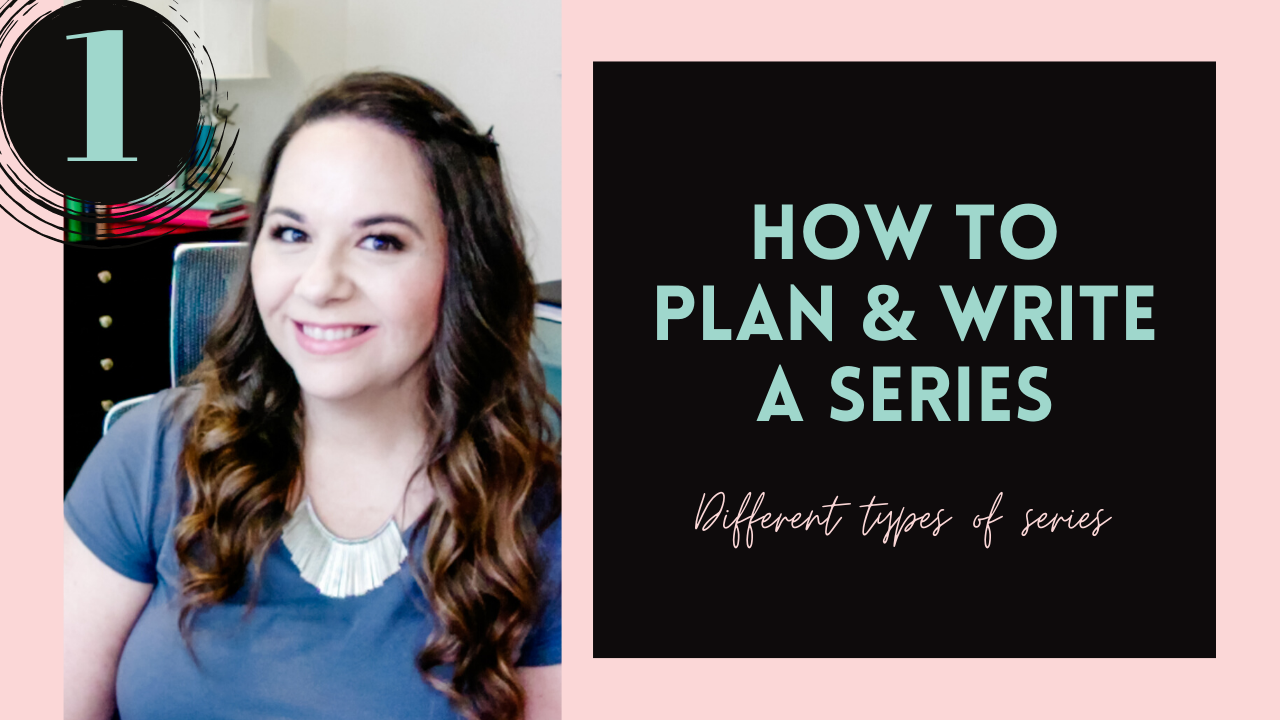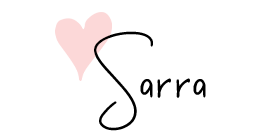

July 9, 2020 by Sarra Cannon
There is no doubt in my mind that writing a series of novels is one of the very best ways to grow your author career and to build a community of loyal readers. Today, I’m starting an 8-part series of videos discussing How To Plan & Write A Series.
Yes, A Series… Series :P.
In this first video and post, we’ll be discussing the different types of series, which genres you’ll most commonly find each type, and some examples of each type of series.
There will also be a free Series Planning Workbook coming soon, so be sure to get on my mailing list.

I plan to post a new video in this series every Thursday, so make sure you’re on my list or subscribed to my YouTube channel for notifications. I’m so excited to bring you this information!
So excited, in fact, that after more than a month of working on this video series, I still think there is so much more to cover. I’m honestly considering a full course on planning and writing a series, where we could get super in-depth on these topics, as well as world building, series branding, and marketing a series.
Let me know in the comments if you think that’s something you’d be interested in!
Series are extremely powerful when it comes to building a readership, because readers love to get hooked into a series of characters or a particular “world” and live there as long as possible.
Series work in just about every genre (and can even work in non-fiction, too!), and I have found and seen them to be the single most valuable tool in growing an author’s career and income.
Today, we’ll talk about the three types of series. Keep in mind, however, that while there are clear examples of each of these types of series, this is something that works on a spectrum.
Sometimes, for example, a series will be more dynamic than another, or two readers might consider the same series to be a different type, depending on their reading preferences. The key is to understand the fundamental differences and then decide where you think your series fits into this.
In some of the examples below, I’ve also included examples of series and genres most commonly using each type of series. These are not hard and fast rules, however, so there will always be outliers and exceptions. Just keep this in mind! In general, I’ve found that when you’re building your author career, it can be a dangerous endeavor to point to an extremely famous outlier and say, “They did it, so I’m doing it!”
More on this in my Publish And Thrive course coming up in August. Be sure to subscribe to my mailing list for news when enrollment opens!
After searching online and asking around, I couldn’t find that there is one industry-standard term for each of these series types. On Kristen Kieffer’s blog, she uses the term “Dynamic” to describe this first type of series, and I rather like that term. For our purposes here, we’ll be using the term Dynamic for this first series type, although I have also heard the terms sequential, chronological, ongoing, and continuing for this type of series.
Also note that with some traditional publishers, when the term “series” is used, they are talking about a Dynamic Series.
So, what is a Dynamic Series?
A Dynamic Series has a continuing story arc that extends over multiple books.
These types of series have a chronological, overarching storyline that takes place over multiple novels and have to be read in order. Each book builds upon the events of the previous book, and for this reason, a reader can’t jump into a Dynamic Series at Book 5 and understand what’s going on.
Each book in a Dynamic Series will have its own main story question or focus that gets resolved, but there is also a larger, overarching storyline or villain that links the events of each book in a sequential structure.
Often, a Dynamic Series will resolve one story question and then end with a zinger of a cliffhanger moment that leads into the main storyline of the next book in the series.
In terms of characters, a Dynamic Series can follow one protagonist all the way through, or there can be a cast of characters that are followed throughout the entire story. These main characters will often experience major growth and transformation over the course of the series.
Examples of Dynamic Series are Harry Potter, The Wheel of Time, A Song of Ice and Fire, Divergent, Twilight, and my own Shadow Demons Saga.
To understand these series and get the full story or have all of your story questions answered, you have to start at the beginning and go to the end, in order.
Genres where you will commonly see Dynamic Series are Young Adult Fantasy & Paranormal, Fantasy, Science Fiction, and Dystopian.
Unlike Dynamic Series, the Standalone Series can be read in any order. Each book in this type of series has its own self-contained storyline that is resolved by the end.
In a series like this, you can start pretty much anywhere. Sure, there are often interpersonal relationships and subplots that tie the books together, so you may have a better experience if you read them in order, but with a Standalone Series, you can pick up Book 5 and expect a fully fleshed-out story with a beginning, middle, and a resolution that leaves you satisfied.
The two main genres where you will find this type of series are in Romance and Mysteries.
With Romance novels, you will often have some unifying element such as a town, a family, or an event. Each book in this type of series will usually feature a different couple, giving you a complete romance with a happily-ever-after ending that leaves you happy and satisfied.
The unifying factor, such as the family, will often have subplots or story threads that are carried throughout the series that will make it more satisfying if you read it in order, but with Standalone Series, you can pick up at any point in the series and expect a complete story that stands on its own.
In a Mystery series, the unifying factor is often the detective or sleuth solving the crimes. Each book will typically have a self-contained mystery or whodunit that is introduced, investigated and resolved to conclusion by the end of that book.
With a detective-style Standalone Series, the detective may have almost no character arc at all. Think about James Bond, for example. Sure, circumstances might change throughout the series for your detective, but there will not be a growth arc that’s quite as sweeping and complete or transformational as you’ll see in a Dynamic Series.
If there is a change and transformation, it’s usually more gradual in a Standalone Series. (With the exception of Romance, as I pointed out earlier, which will have the full character and story arcs in each novel.)
Examples of popular Standalone Series are Jack Reacher, Bella Andre’s The Sullivans Series, James Bond, and my Fairhope Series.
Genres, as mentioned earlier, where you will commonly find Standalone Series are Mystery, Thrillers, and Romance.
Most blogs and information I found online only listed two types of series, but in my mind, there is a third hybrid type of series that deserves a mention, as well.
The Episodic Series is a combination of both Dynamic and Standalone elements.
Episodic Series often have a mystery format or structure where the main case or plot of each book is resolved, but these books will also have elements that are so closely interconnected that you would miss out on major storylines and interpersonal relationships that you need to read them in order.
Often, most of the books in an Episodic Series will have its own full plot or whodunit-style mystery that is fully resolved in terms of this one case, but there will also be a major tie-in to a larger storyline or mystery that spans several books.
With an Episodic Series, you could expect to jump in on Book 5 and get the general idea of the story and reasonably follow along (more so than with a Dynamic Series), but you’d also be missing a ton of subplot and relationship threads that came before (more so than with a Standalone Series).
Another way these series are structured is that there will be several books where the resolved mystery leads to another part of the same larger mystery, and our hero or heroine fights a series of mini-bosses before finally fighting or confronting the main boss of the story.
These stories are often interlinked enough that you really wouldn’t want to read them out of order, even though you could.
Examples of Episodic Series are The Dresden Files and the Eve Dallas In Death Series.
Thinking about series in terms of Television shows you may have seen or heard of before, here are a few examples.
An example of a Dynamic Series would be Game of Thrones. Each episode and season builds upon the last, and there’s really no way to fully follow the story unless you start at the beginning and go all the way to the end.
Now, whether you like the ending or not is up to you. 😛 We won’t go there. (I loved it. Don’t hate me.)
An example of a Standalone Series is Law & Order. There is generally one case per episode. You’re introduced to the murder, watch the investigatation, and the killer is caught and prosecuted by the end. You can jump in on Season Three or Season Ten at any point and enjoy a full story.
What links these episodes are the group of detectives and the city they live in. While there are larger story arcs here and there, for the most part, you aren’t missing anything if you watch out of order.
An example of an Episodic Series is Supernatural. Similar to Law & Order, you’ve generally got one case per episode that is introduced, investigated, and resolved. However, there is a much larger, overarching story of the relationship between Sam and Dean, their relationship with their father, and various storylines regarding different villains in the world.
In many instances, you could jump in on an episode later in the series and find a complete story arc with an investigation going on. However, you’d have missed so much interpersonal relationship and world building that you’d really get confused or miss the magic, so to speak.
Thinking about these three types of series, which type do you think you are currently writing or most interested in writing?
Most of my series are Dynamic Series, but I have written two series (Willow Harbor and Fairhope) that were Standalone Series. In some ways, I would even say that my Fairhope series leans more toward an Episodic Series than Willow Harbor does, because more of the relationships and subplots that are carried through depend on reading the books that came before.
One of the biggest questions to ask yourself here is, “Can a reader jump in at any point in the series and get a complete, standalone story?”
If you’d like to check out some of my series, you can find a list of them here on my website.
Over the coming weeks, I’ll be exploring the idea of How To Plan And Write A Series of your own in great detail. I can’t wait to go on this journey with you!


I have been self-publishing my books since 2010, and in that time, I've sold well over half a million copies of my books. I'm not a superstar or a huge bestseller, but I have built an amazing career that brings me great joy. Here at Heart Breathings, I hope to help you find that same level of success. Let's do this.
Thanks for this series on series! I’ve written one before but want to learn more about the nuts and bolts to make the process easier.
Thanks, this was helpful! I’m working on pitching to literary agents the first book in a novel series and was looking around for industry jargon terms for what to call the series. Thanks to your help, I’ll call it standalone!
Fantastic!
Thanks for the helpful video! Hearing you say (so calmly) how many series you’ve written is encouraging 😀 Where can I find the guide download to writing/plotting a series?
If you’re on my mailing list, you can find it inside the Resource Library! Just search for the pdf titled “Plan_And_Write_Your_Series”. If you aren’t on the mailing list yet, you can join at this link: https://heartbreathings.com/newsletter/ and I’ll send you a link to all my resources via email!